WEnRV travel news, products, and industry trends
9 Not-So-Spooky Ghost Towns You Should Visit Out West
The second half of the 19th century marked a huge influx of people moving West. With dreams of getting rich, miners and investors alike flocked to the Western states to seek their fortunes while towns and mining settlements popped up overnight. When the mines dried up, the towns were abandoned and faded into obscurity. Throughout the West, you’ll find the remnants of these “Boom and Bust” towns scattered around the countryside, some found right off the road while others may require a hike or bumpy ride into the mountains. Though the towns might be long abandoned, their rich history continues to tell a tale.
Sprucemont, Nevada
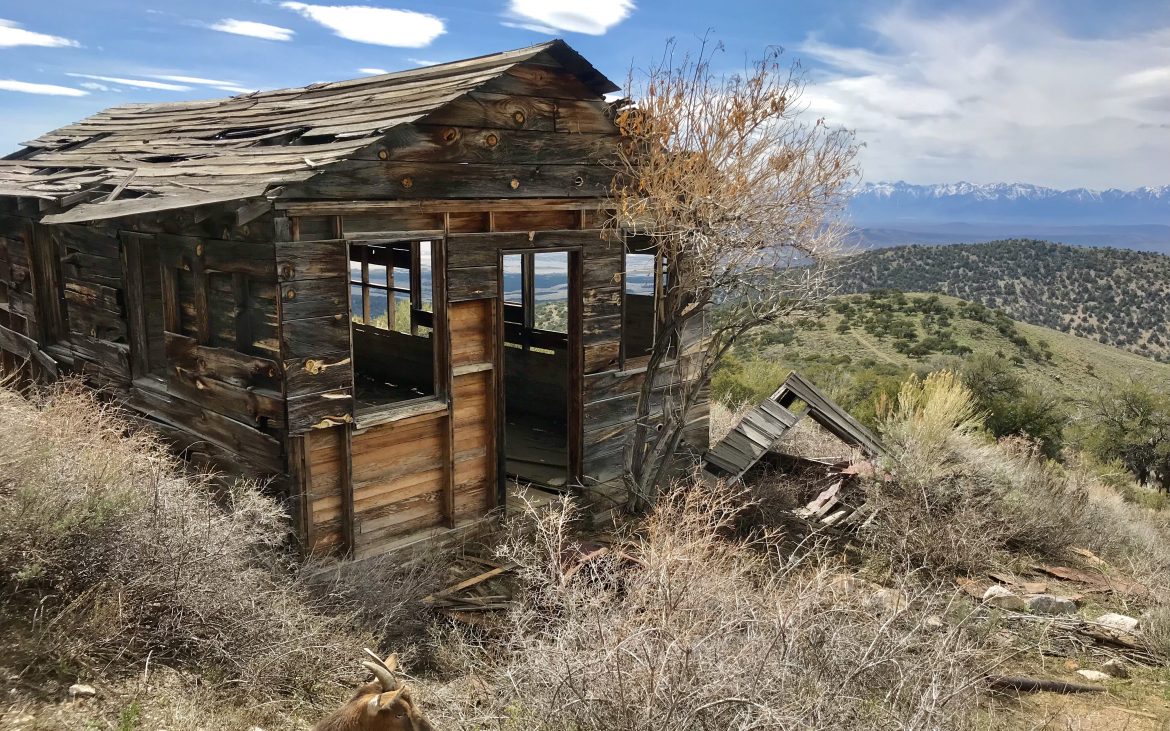
Frankie the goat explores an old cabin at Sprucemont. Photo Credit: Cate Battles
Situated in Northeastern Nevada, the Spruce Mountain Complex, was a mining district that flourished during the last half of the 19th century. Within the complex, you’ll find the mining camp of Sprucemont, perhaps the best-preserved ghost town in Elko County, with numerous buildings, ore chutes, and mines dating back over 150 years ago. The scenic drive to Sprucemont starts about 40 miles south of Wells as the road winds its way up the mountain, offering fantastic views of the Humboldt Range, Ruby Mountain Wilderness, and the Clover Valley below.
Dating back to 1869, when lead-silver ore was discovered at the Latham mine, prospectors began flocking to the area with dreams of striking big. Within a few months, around one hundred miners were working claims on the western and eastern slopes of Spruce Mountain and several new mines were erected. A year later, the different mining districts were consolidated into one district called the Spruce Mountain Complex. In 1930, low lead prices caused many of these mining companies to fold, and several mines stopped production. Though 1945 was the biggest yielding year for Spruce Mountain, all serious mining ended by 1952 and the land was taken over by the BLM.
When you visit today, the gravel road to the first town of Sprucemont is in excellent condition and provides several great boondocking opportunities along the way. Further up the rough road, high clearance vehicles or ATVs are needed to get to Monarch Mine, or you can choose to hike.
Stay: Iron Horse RV Resort, Elko, Nevada – Located against the beautiful Ruby Mountains. Ironhorse was listed in the top 100 RV parks by Good Sam Club. The Ironhorse grounds are surrounded by mature green grass and landscaping.
Bodie, California
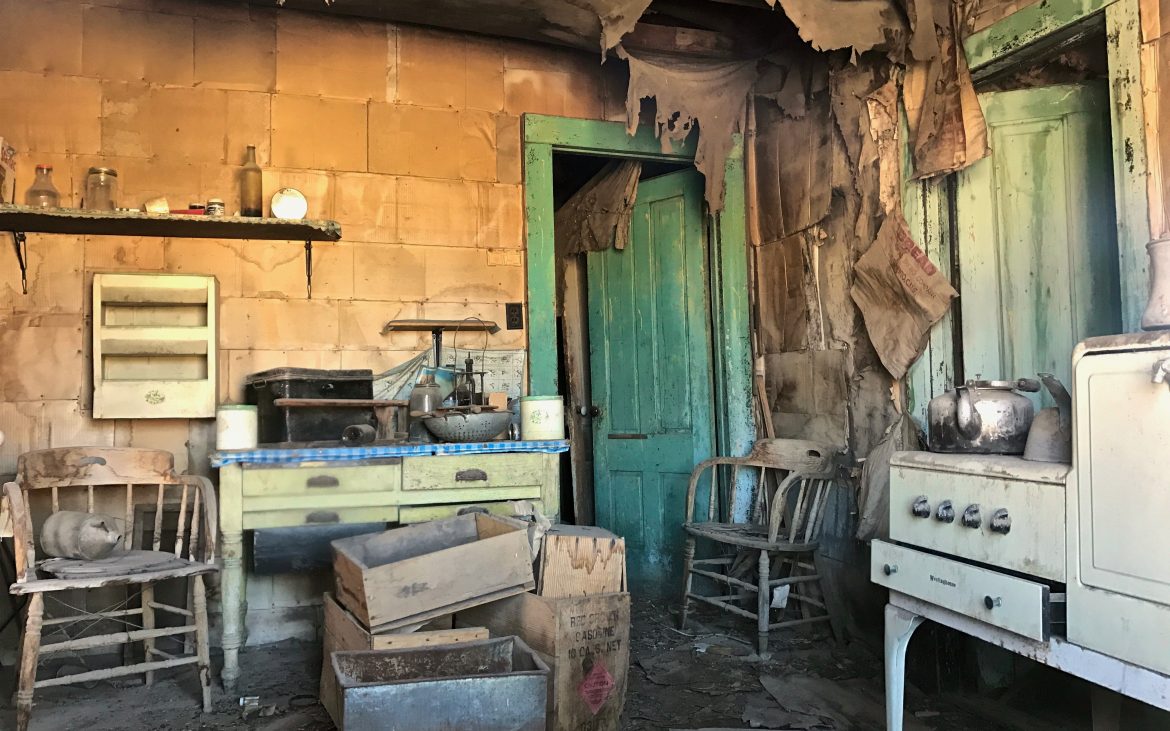
The buildings interiors were left untouched after the residents left. Photo by @CateBattles
Tucked away along the Eastern Sierra between the towns of Bridgeport and Lee Vining is the historic settlement of Bodie. Arguably the most extensive ghost town of the ‘Old West’ with over 110 buildings still standing, Bodie State Historic Park remains in arrested decay, offering visitors the most authentic ghost town experience you can get.
The small mining camp became a boomtown after a profitable deposit of gold was found in 1876, bolstering the population to 10,000 people, and at one point, was one of the largest cities in California. Its next claim to fame was creating the world’s first long distance electrical transmission network, which changed the mining industry on a global level. After several fires, it was abandoned by 1950 and became a National Landmark in 1961. This park is pet-friendly and many building are open to visitors, otherwise, you can peek through the windows to see the untouched and dust covered interiors.
Stay: Yosemite Lakes RV Resort, Groveland, California – Set in one of the most majestic settings in the country just outside Yosemite National Park. Plenty of swimming, fishing & panning for gold in the Tuolumne River that runs through campground.
Silver City, Idaho
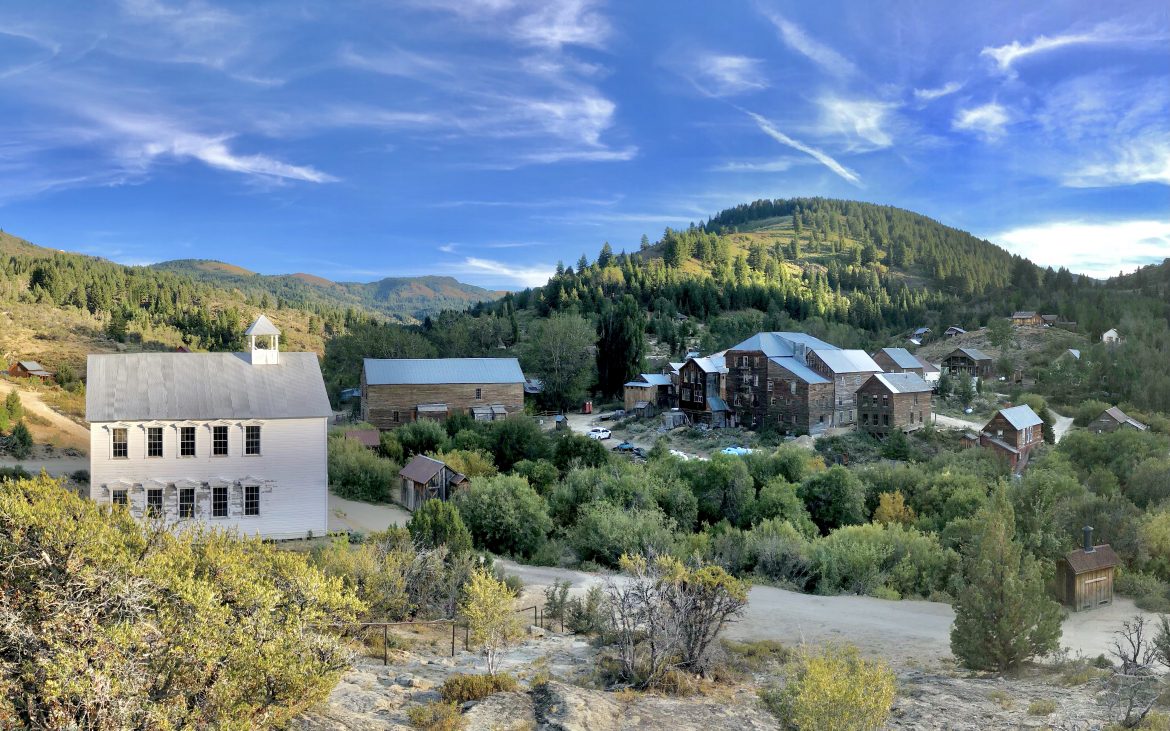
Around 70 buildings remain in Silver City Photo Credit @CateBattles
Though technically not a ghost town, as there are still a few residents, Idaho’s Silver City is one of the last remaining mining boom towns of the West that was not lost to fire or modern commercialization. It’s truly a blast from the past, since most of the 70 intact buildings remain much like they did at the turn of the 20th century. This picturesque but isolated town is surrounded by the 8,000ft high Owyhee Mountains and sits at an elevation of 6,200ft. The town was founded in 1864 shortly after silver was discovered nearby, and quickly became one of the biggest cities in Idaho Territory. At one point, it had over 75 businesses, 300 homes, and a population close to 2,500. It claimed Idaho’s first daily newspaper and telegraph office and was one of the first Idaho cities to receive electric and telephone service.
Silver City saw its decline around 1890 when the placer and quartz vein mines became depleted and due to its remote location, many miners and families moved elsewhere. There are still some part time residents here, including Roger, the proprietor of the Idaho Hotel and Saloon and a few 4th generation descendants of the miners.
Stay: Mountain Home RV Resort, Mountain Home, Idaho – Minutes from golf, hunting, fishing, bird watching, water sports and winter sports too!
Miner’s Delight, Wyoming
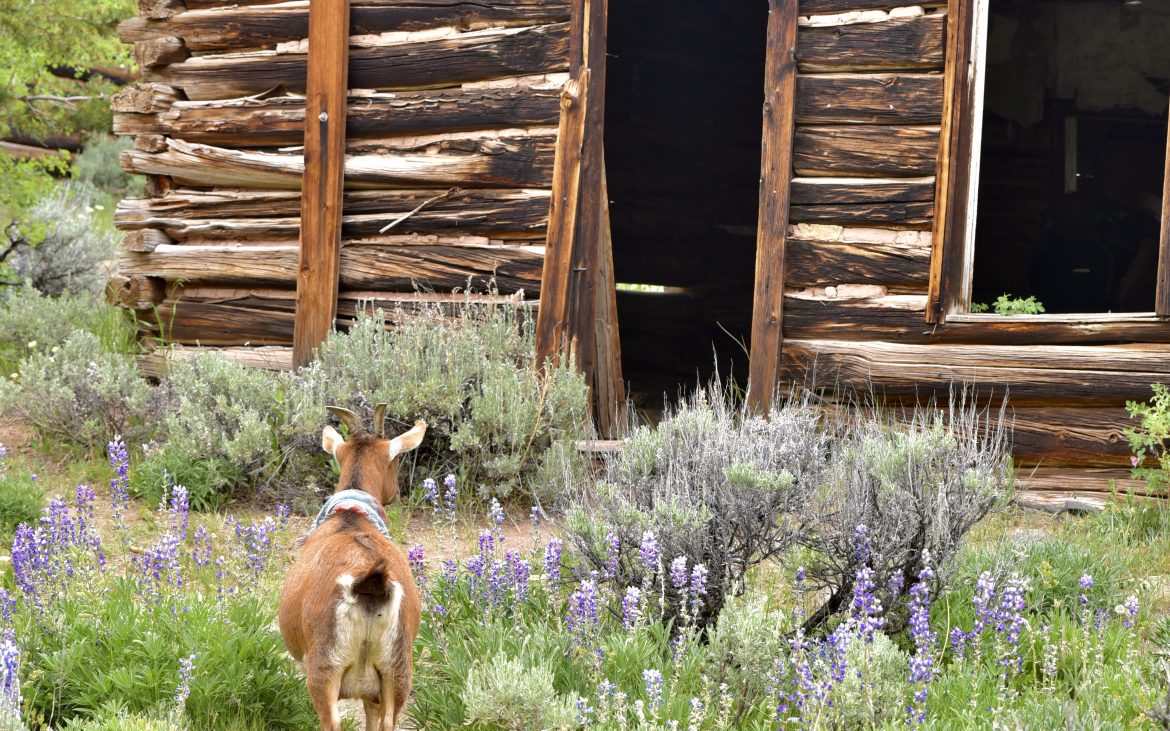
Lupine covers the land that surrounds Miner’s Delight in June. Photo Credit @catebattles
Miner’s Delight, located near the Southeastern corner of Wyoming’s Wind River Range is one of several remaining ghost towns in the South Pass area. Originally founded in 1867, shortly after gold was discovered, the town’s population peaked around 100, and was the childhood home of Calamity Jane. Like most boom-and-bust towns, the town’s popularity fluctuated, and was abandoned and repopulated at several points from the late 19th century until the Great Depression. The last residents moved out in the 1960s, and today there are only ruins. While visiting, you can explore the small cemetery along with the dozen or so structures left of the small mining community. Down the road, drop by the more restored Atlantic City and South Pass City.
Stay: Sleeping Bear RV Park & Campground, Lander, Wyoming – Lander Wyoming is a bustling small town filled with outdoor adventures, summer activities, small shops and more.
Golden, Oregon
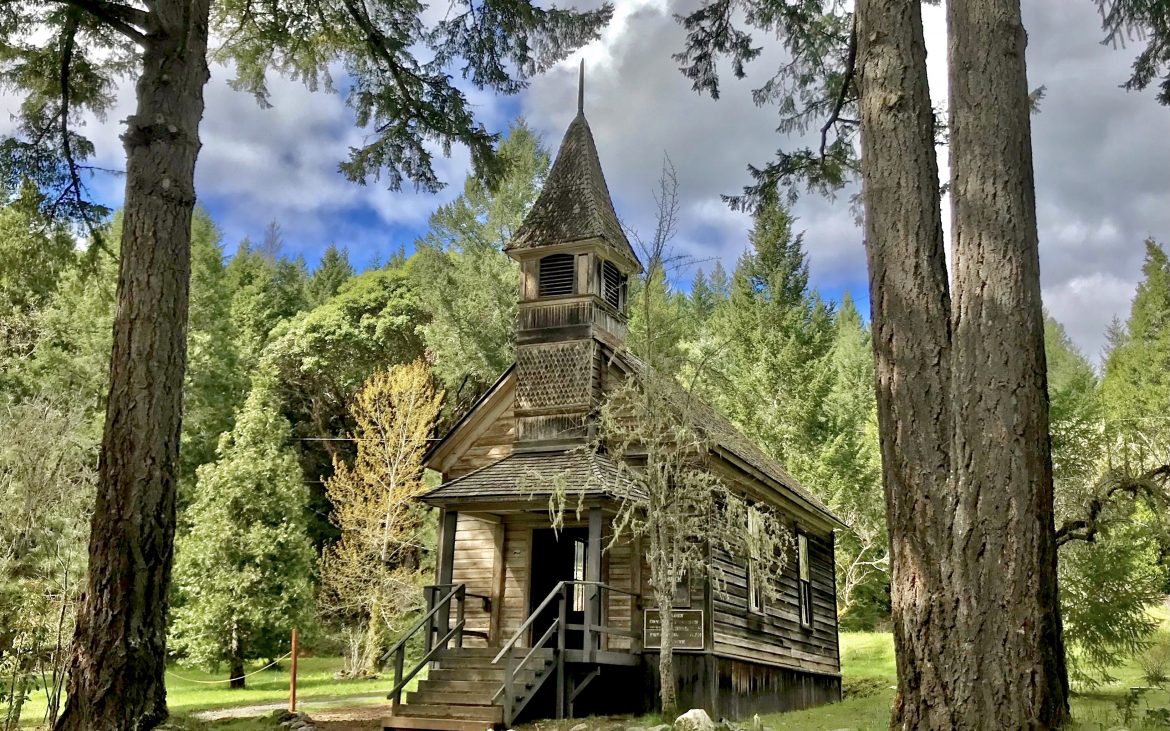
A church is one of the few structures remaining that you can tour. Photo Credit @cateBattles
During the 19th century gold rush, many miners who flocked to California continued north to the Rogue Valley and laid claim to the land along Coyote Creek, in Southern Oregon. When gold was discovered in Idaho’s Salmon River, many of these early miners left and the abandoned settlement was taken over by Chinese immigrants. At the time, there were about 500 Chinese men working these mines at 10 cents/day plus rice rations. When Idaho’s gold rush slowed down years later, many miners returned to reclaim the mines the Chinese had operated between 1862-1972, unfairly forcing the immigrants out.
Gold production really started to ramp up, as did the population with the introduction of hydraulic mining during the 1870s which garnered 1.5 million dollars worth of gold from the water and hillsides. The Ruble family who owned a large portion of the land officially established the town of Golden in 1890. One of the most unique aspects of Golden, and the reason why it’s nicknamed the “Driest mining town in Oregon” was the fact that it had two churches and no saloons. The Ruble family were strict Christians, so if a miner got thirsty, he had to travel to nearby towns for alcohol or dance halls. After a few decades, gold production slowed down and people started to leave in search of other opportunities. The post office closed in 1920 and by the mid 20th century, the town was abandoned. Today, Golden is listed on the National Register of Historic Places and as of 2011, is an Oregon State Heritage Site.
Stay: Seven Feathers RV Resort, Canyonville, Oregon – In the ‘Land of Umpqua’ this resort is nestled in a canyon of Douglas fir and pines where their fragrance lingers long after quiet hours. Located off I-5 at exit 99 in Canyonville, enjoy the casino, dining, wine tasting tours, spa and pool.
Bonanza, Idaho
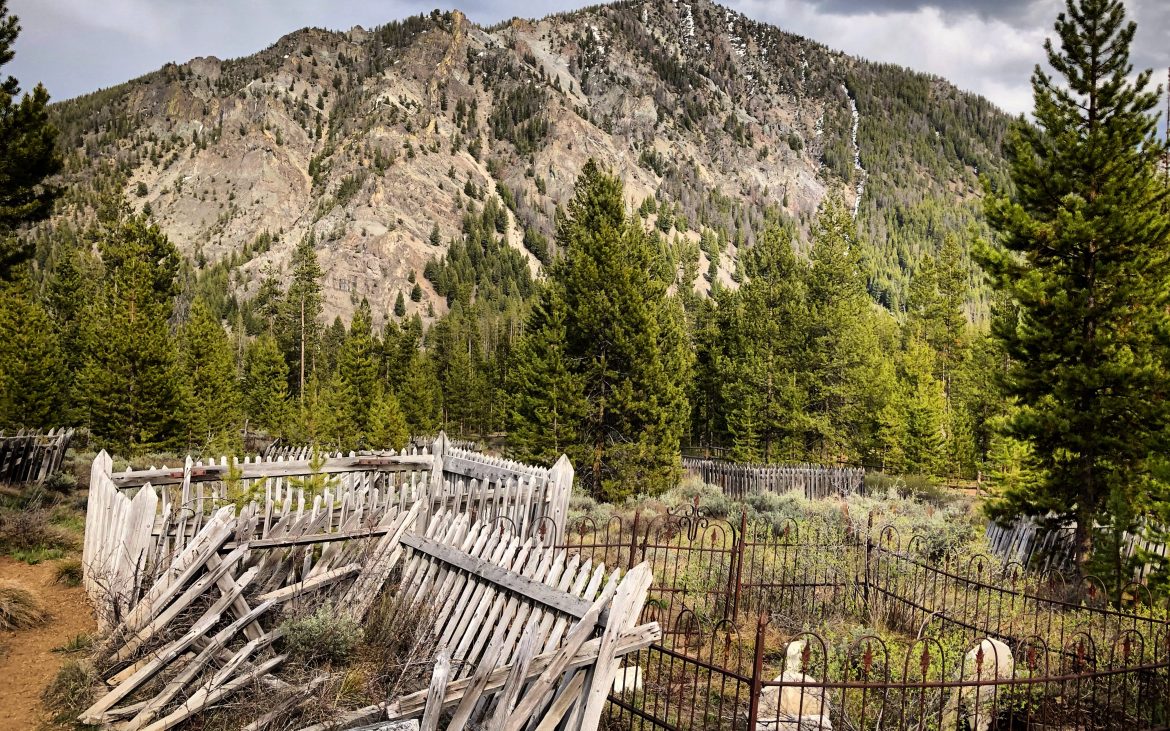
The cemetery, just a short drive from the town is not to be missed. Photo Credit @CateBattles
Located in the Sawtooth National Recreation Area, the dilapidated ruins of Bonanza offer a glimpse of what life was like for miners in the Idaho Territory. Settled in 1877, Bonanza, Spanish for prosperity, was the first mining settlement in the Yankee Fork area of Central Idaho. By 1881, it had become the largest mining town in the area and home to over 600 residents. In its heyday, this charming town in Salmon River country had implemented a water system, enjoyed tree-lined streets, and was the first town in Custer County to have a daily newspaper. Additionally, Bonanza had a baseball field, a small racetrack, and a croquet field.
Things took a turn for the worst when a fire broke out in 1889, burning much of the town, and forced residents to relocate to the nearby community of Custer. By 1890, only 136 residents remained and by 1910, the town was mostly abandoned after the mines dried up. Today, the land is privately owned, but open to the public. Visitors can tour around the remnants of the town as well as the impressive cemetery about a half-mile away. While there, keep an eye out for mountain goats, as they call the surrounding mountains home.
Stay: Wagonhammer RV Park & Campground, North Fork, Idaho – Located in northeastern Idaho near the Montana state line just 19 miles north of Salmon Idaho our North Fork Idaho RV Park and Campgrounds is on the banks of the Salmon River, adjacent to Highway 93 and in the heart of the Central Idaho Rocky Mountains.
Rhyolite, Nevada
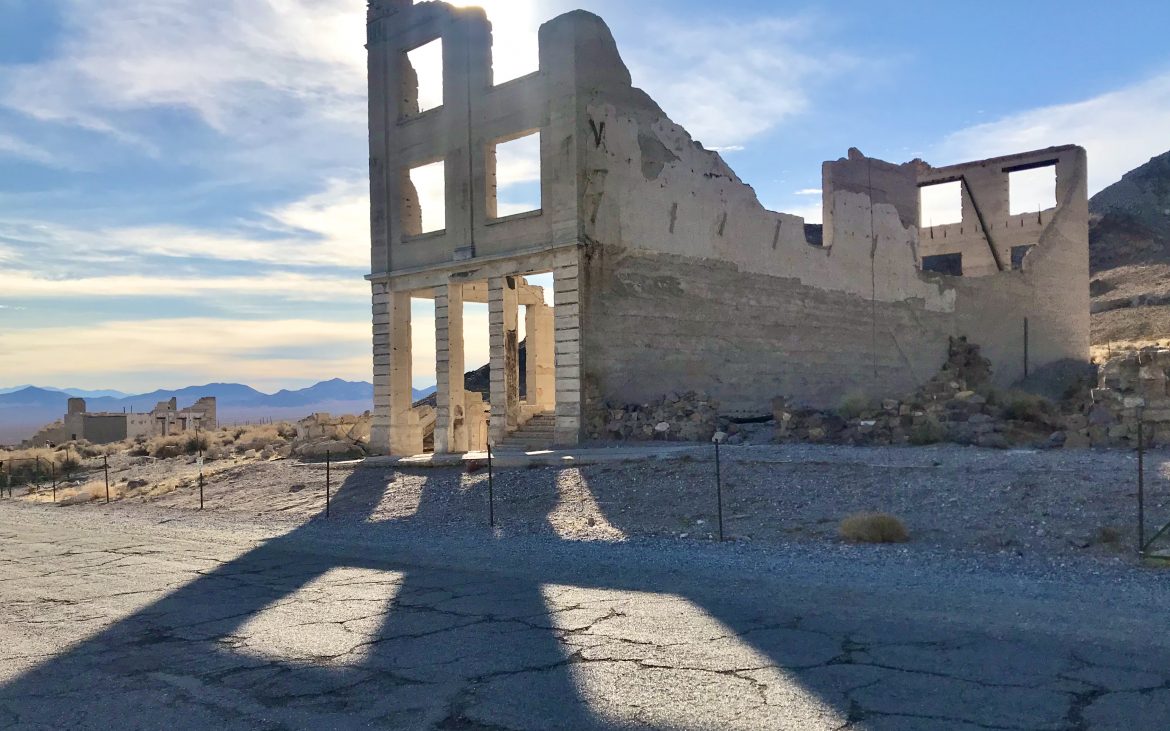
The Cook bank is one of several remaining ruins to explore in Rhyolite. Photo Credit @CateBattles
While visiting Death valley national park, it would be a mistake to skip Rhyolite, an easily accessed ghost town outside of Beatty, Nevada. Founded in 1905, shortly after a couple of prospectors discovered high-grade ore, miners, developers, and service providers flocked to the area in what was soon to be called the Bullfrog Mining District. At its peak in 1907, the town was home to 6,000 people and boasted over 50 saloons, 16 restaurants, and 19 lodging houses. Rhyolite was equipped with electric lights, water mains, telephones, newspapers, schoolhouse, hospital, opera house, and a stock exchange.
The town saw its demise when the mines were exhausted and its downfall was further exacerbated by the devastating San Francisco earthquake in 1906 shortly followed by the financial panic of 1907. These catastrophic events dried up funding for the mines and investors looked elsewhere, creating a mass exodus for this boom and bust town. By 1910, the population dropped to 675 and all three banks closed their doors. In 1914 the last train left Rhyolite and by 1916, the power was turned off. The town, which declined as rapidly as it rose, became a favored Hollywood film set and tourist destination.
While visiting the ruins, drop by the art installations next door, most notably Albert Szukalski’s ghostly 1984 sculpture “The Last Supper”.
Stay: Lakeside Casino & RV Park, Pahrump, Nevada – Relax at Lakeside, enjoy the hot tub, swimming pool, sandy beach, cabanas, fire pits, pedal boats & fish in the 7-acre lake. It’s also a short walk to the casino for 24-hour action!
Metropolis, Nevada
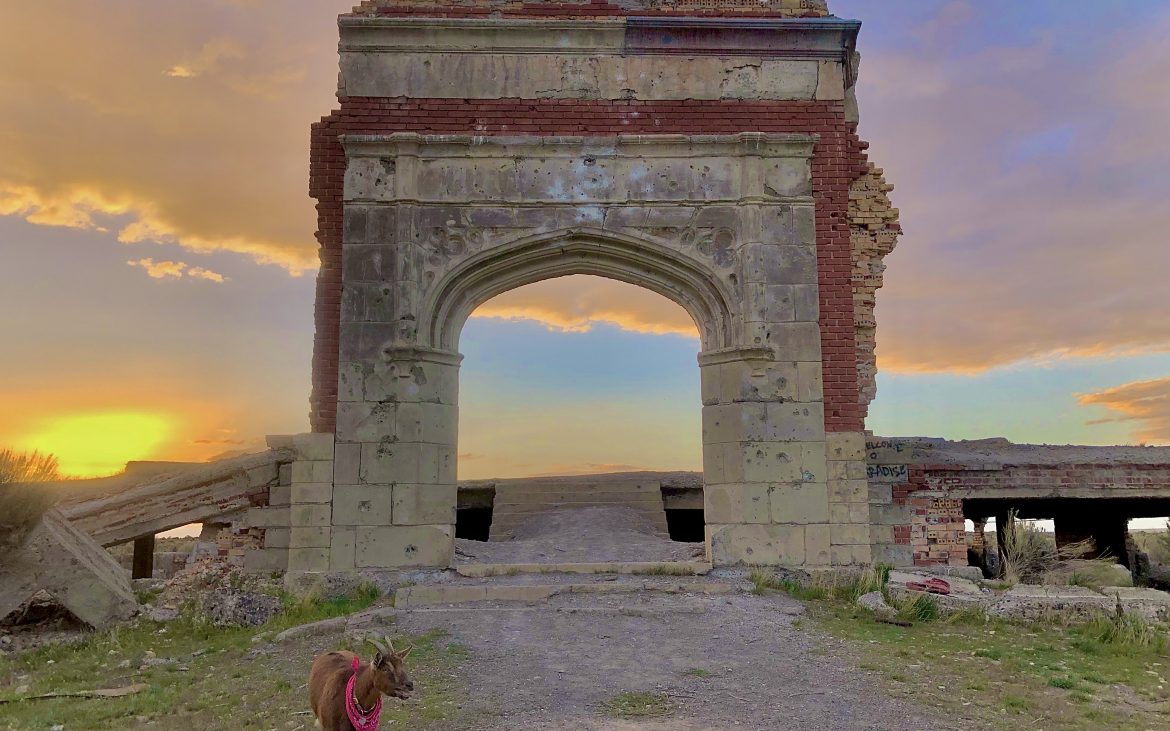
Frankie stands in front of the old Metropolis school. Photo Credit @CateBattles
Metropolis is unusual in several ways, but what really makes it stand out is the fact it’s one of the very few ghost towns of the West that had nothing to do with mining. In 1910, the Pacific Reclamation Company bought 40,000 acres of land northwest of Wells, Nevada with plans of making a modern farming community. They created an intricate irrigation system along with a dam along Bishop Creek and provided the town with a modern hotel, school, post office, train depot, and a multi-purpose amusement hall. A few years later, the Southern Pacific Railroad built a spur to the town, which in turn, created a population boom. In its heyday, the population peaked around 700 people, many of who were Mormons from Salt Lake City, hoping to start a new life at this would-be farmers paradise.
However, their luck faded fast when the town fell victim to a perfect storm of devastating events. The first major blow was a lawsuit that cost them their water rights. Around the same time, a Typhoid epidemic wrecked havoc on the town, and if that wasn’t bad enough- after the farmers killed off the coyotes, the jackrabbit population decimated the town’s crops along with the Mormon crickets. The company declared bankruptcy in 1920, the railroad discontinued service, the hotel burned down in 1936, and the school taught its last class in 1947. And that was the end for Metropolis.
Today, you can take a 20-minute drive from Wells to visit the ghost town. The only structures still standing are the ruins from the school, hotel, and the nearby cemetery.
Stay: Mountain Shadows RV Park, Wells, Nevada – Located next to the Humboldt and Ruby Mountains, this RV park allows a great opportunity for hiking, biking, fishing,
Custer, Idaho
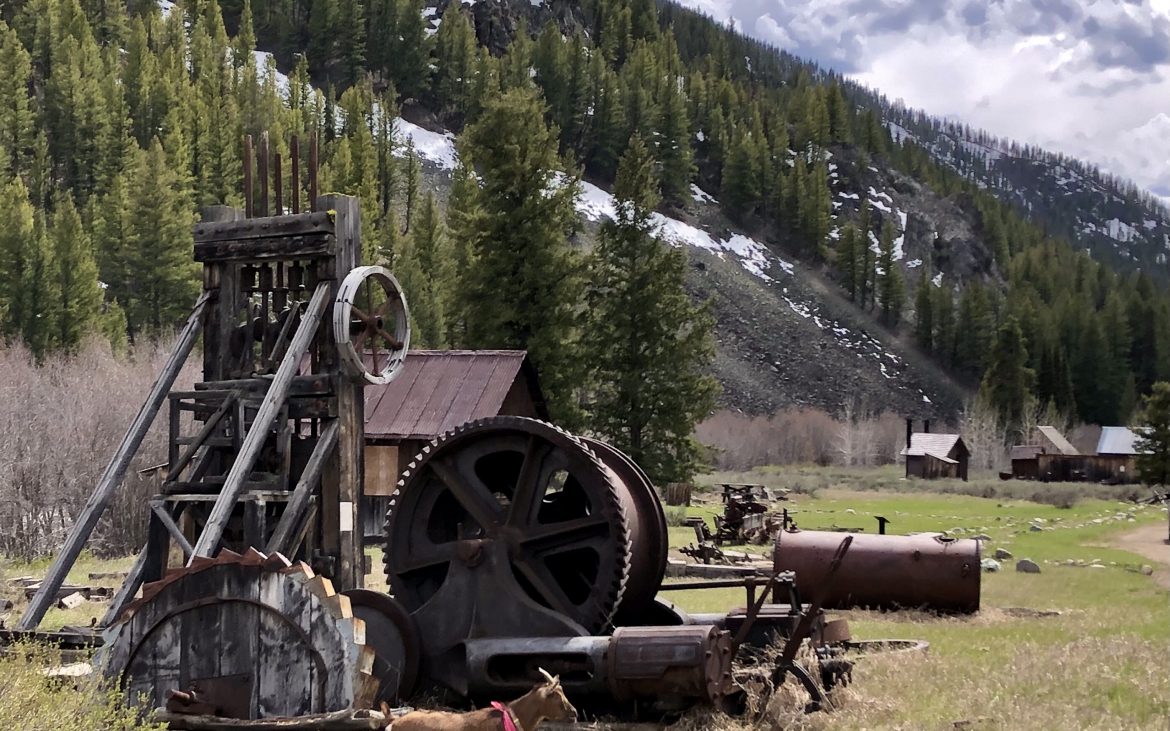
Frankie explores the mining equipment strewn around Custer. Photo Credit @CateBattles
Considered the sister city of Bonanza, the spirit of the Wild West is preserved in the Sawtooth Valley’s Custer ghost town, where miners worked their claims during the 19thcentury Gold Rush. Just a short drive from Stanley, Idaho the old Yankee Fork toll road leads to the historic town of Custer, a few miles past the ruins of Bonanza. Founded in 1879, the one street town was built below the General Custer mill site. The town reached its zenith after the fires burned down the neighboring town of Bonanza bolstering its population from 300 to about 600 residents. When the last major mine was discontinued in 1911, the town’s population quickly faded. Today, you can take a free self-guided tour around the towns and cemetery. While there, make sure to stop at the impressive Yankee Fork Dredge, one of the most intact dredges in the lower 48. This 988-ton piece of machinery was used in the mid 20th century to extract nearly $1 million in gold from the five-mile stretch of land along Yankee Fork.
Stay: Challis Golf Course RV Park, Challis, Idaho – Fish, raft or kayak on the Salmon River or explore nearby ghost towns. ATV riding & hiking are plentiful here with many mountain ranges.
The post 9 Not-So-Spooky Ghost Towns You Should Visit Out West appeared first on Good Sam Camping Blog.
Copyright
© Good Sam Camping Blog


